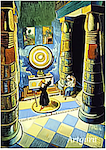Electrum-Magicum

Alchemical Table Bell
*** Emperor Rudolf II (1552-1612) was Holy Roman Emperor, King of Hungary and Croatia, King of Bohemia and Archduke of Austria. He was a member of the House of Habsburg.
This is a beautiful alchemical table bell of the emperor, made around 1600. It is held in the Kunsthistorisches Museum in Vienna, Austria.
According to the museum's information, Emperor Rudolf II is reputed to have used this bell in his practice of alchemy. Goldsmith Hans Bulla (of Prague) claimed to have cast the bell from an alloy of seven different metals, called "electrum" in alchemical texts. Its decorations, including the seven planetary gods, their symbols, and the associated zodiac signs, as well as Greek and Hebrew letters on the interior, relate to rituals and beliefs associated with alchemy.
The alchemical electrum concerned here is made of the seven metals (gold, silver, mercury, copper, tin, lead and iron). This is in contrast to the usual electrum that is an alloy of gold and silver alone, and used to make jewelry. In some alchemical or Rosicrucian works, electrum is a symbol for a perfect product at the end of the Great Work, spiritually or physically.
In alchemy, the planets relate to the seven metals, the zodiac relates to the time it takes to perform the Great Work. It is clear that this bell is connected to magical practices. Ringing bells is a common practice in shamanic rituals.
Is it coincidence that the ritual objects of the Tibetan Lamas, who are initiated into magic, include the now well-known singing bowls, as well as their tingsha's (little cymbals) and bells, all of which were made of seven metals, at least before the Chinese invasion of Tibet. Once the tourists and the New Age people became interested in these objects starting in the 1960's, the Nepalese metallurgists were not interested in the effort required to make magical objects (by including all seven metals) for these people.
The famous magician Aleister Crowley mentions in his Liber 860, on page 8, that he used a Tibetan bell, made of electrum, in a lesser Banishing Ritual in September 1908:
Also I took the Almond Wand of Abramelin and the Secret Tibetan Bell, made of Electrum Magicum with its striker of human bone. I took also the magical knife, and the holy Anointing Oil of Abramelin the Mage. I began then quite casually by performing the Lesser.
In his other book, Book 4, under Chapter 14: The Bell, he again talks about this bell, but the description he gives, shows that he is actually talking about a tingsha:
This Bell summons and alarms; and it is also the Bell which sounds at the elevation of the Host. It is thus also the “Astral Bell” of the Magician. The Bell of which we speak is a disk of some two inches in diameter, very slightly bent into a shape not unlike that of a cymbal. A hole in the centre permits the passage of a short leather thong, by which it may be attached to the chain. At the other end of the chain is the striker; which, in Tibet, is usually made of human bone. The Bell itself is made of electrum magicum, an alloy of the “seven metals” blended together in a special manner. First the gold is melted up with the silver during a favourable aspect of the sun and moon; these are then fused with tin when Jupiter is well dignified. Lead is added under an auspicious Saturn; and so for the quicksilver, copper, and iron, when Mercury, Venus, and Mars are of good augury. The sound of this Bell is indescribably commanding, solemn, and majestic. Without even the minutest jar, its single notes tinkle fainter and fainter into silence. At the sound of this Bell the Universe ceases for an indivisible moment of time, and attends to the Will of the Magician. Let him not interrupt the sound of this Bell.***
I was able to create Electrum-Magicum with the help of an alchemist after meeting him in a lucid dream.
Refine Search
There are no articles.
